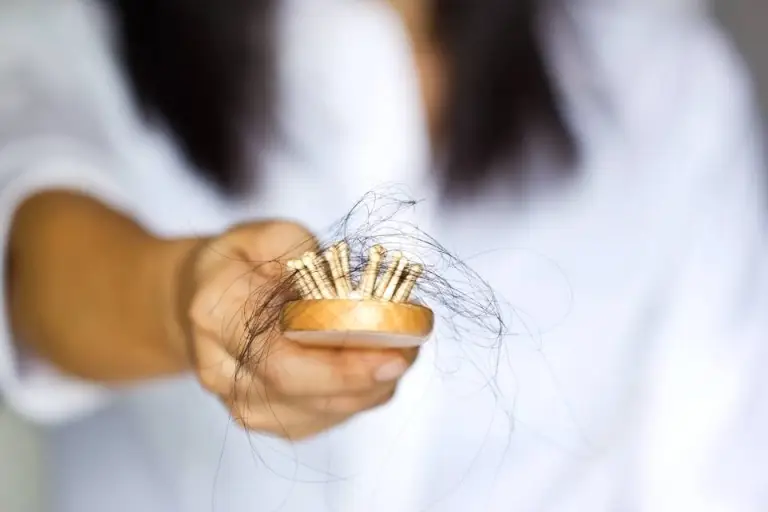There is a tendency to think that women lose much less hair than men. This is true, but the percentage of women who have some type of alopecia during their lifetime reaches up to 30%. What types of baldness can we find in them? Is there a treatment for them?
Androgenic alopecia
The most common cause of alopecia in women is androgenic alopecia, which is of hormonal and genetic origin. In this alopecia, women notice a loss of hair density, the parting becomes wider and the scalp is visible
This is not the only form of alopecia. The following may also appear:
Telogen effluvium or “stress hair loss”
It appears as a result of a stressful process, whether physical or emotional. We are currently seeing a lot of telogen effluvium in patients who have had COVID-19 or due to the stress of confinement.
The most common case is intense hair loss. Patients often bring a bag with the hairs that have fallen out when they wash themselves (Figure 2). This causes the ponytail to lose volume and the hairline to lose density.
Despite its spectacular appearance, the hair will grow back after a few months. It is a reversible type of hair loss with a good prognosis.
Alopecia areata
Its origin is autoimmune. In this case, circular areas of alopecia appear quickly (Figure 3), which can lead to generalized hair loss.
It requires an adequate dermatological diagnosis since it has a specific treatment: corticosteroids, immunosuppressants, and even immunotherapy.
Frontal fibrosing alopecia
A type of scarring baldness of autoimmune and hormonal origin. Its incidence has increased dramatically in recent years, and the reason for this is still unclear.
Women who suffer from this alopecia are usually over 50 years old, although we are increasingly seeing more cases in younger women. They tend to lose their eyebrows and have alopecia in the area of the forehead and sideburns (“headband alopecia”, figure 4).
Treatment is based on antiandrogens and anti-inflammatories.
The importance of diagnosis
The above are the most common causes of baldness in women, but not the only ones. Other alopecias can be found: traction, lichen planus pilaris, folliculitis decalvans, and drug-induced.
There are more than one hundred different types of alopecia, so diagnosis is essential before considering treatments.
To do this, the dermatologist specializing in trichology (a branch of dermatology that deals with hair problems) has tools such as digital trichoscopy (a non-invasive method), which allows diagnosis in the consultation itself and to decide on the treatment on the spot.
Treatment
Today there are very effective therapies to not only stop but also improve hair density in patients with alopecia. Let’s focus on the treatment of androgenic alopecia, which is the most common form of female alopecia.
First of all, the patient must be aware that the medical treatment will be effective as long as she uses it. Therefore, a strategy must be designed that is comfortable, since she will have to maintain it in the long run. I usually explain to my patients that the treatment of alopecia is a “long race.”
In some patients, and as long as they are good candidates, we can also perform a hair transplant to improve density in areas where medical treatment cannot do more.
We could summarize the main medical treatments as follows:
- Minoxidil: a medication for topical or, in recent years, oral use. It allows hair to thicken through different mechanisms. It takes a few months to take effect and the maximum effect is usually seen after one year.
- Antiandrogens: Drugs that can be used orally, topically, or by microinjections into the scalp. There are different types: finasteride, dutasteride, spironolactone and bicalutamide. The choice will depend on each patient and the degree of alopecia. Microinjections are of dutasteride due to its longer half-life (figure 6).
- Other treatments: There are multiple therapies with a somewhat lower effectiveness profile. For example, platelet-rich plasma, microneedling, and low-power laser. They allow for the design of an individualized treatment strategy for each patient.
- The future: Many patients ask us about the status of stem cell therapy or hair cloning. It is currently in the experimental phase and cannot be performed in clinical practice. If we are optimistic, it may become a reality in 6 to 8 years.
Hair transplant in women?
In addition to medical treatment, some patients may benefit from a hair transplant. To do so, you will need to have “good raw material”, as it is a minimally invasive surgery in which we transfer hairs (one by one) from the nape of the neck to the area of alopecia.























+ There are no comments
Add yours